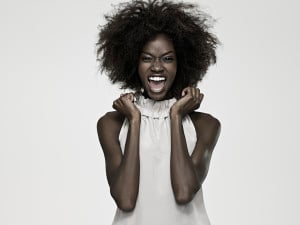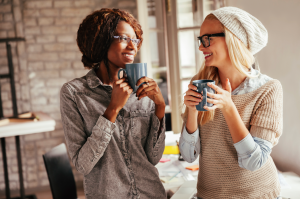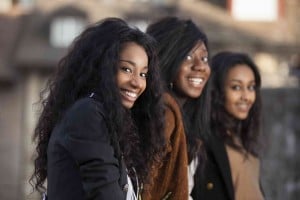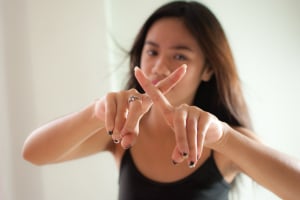
Source: Ebony
I arrive at the all-Black natural hair salon with slight apprehension.
I need my hair retwisted something serious and am still searching Oakland for a regular place that I like. I am greeted warmly by the stylist – a smile coming across her deep chocolate face – but I am still wary.
The apprehension increases some as we make our way over to the shampoo bowl and she starts in on the topic of intimate relationships. “You married, baby?” she asks. I laugh and shake my head “no.”
Later on, as she is palm-rolling my hair, she asks my opinion about older men who are always chasing after younger women – she thinks they’re “sorry.” At this point, feeling like we’ve built enough in our conversation, I respond with an unsure laugh. “I’m gay, I don’t know much about it.”
“Oh.” Brief silence, more palm-rolling. And, almost as if on defense, she says, “Well, I ain’t got no problem with that. You are who you are, you love who you love.”
Any initial hint of worry melts away.
Some years earlier, I never would have shared so much of myself. Not only was I still exploring my identity and all of its complexities – I also had internalized the over-simplified stereotype of an unforgivingly homophobic and closed-minded Black community.
My fear led me to believe that I had to choose only certain parts of myself to share – depending on the space that I was in – and I had grown used to adhering to that fear. I thought I had to abandon conversations about racism in white queer spaces or neglect any behaviors that may hint at my gender and sexual identity around Black folks.
Where did this fear come from?
Black people have long received the stamp of being intolerant, hateful, and violent towards members of the LGBTQIA+ community.
But just like any other stereotype, the truth is much deeper and more complicated than some easily consumed narrative used to validate one’s own prejudice.
As an openly Black, queer, and gender non-conforming person who has navigated all-Black spaces, predominantly white LGBTQIA+ spaces, and Black queer spaces, I want to delve deeper.
Is the African American community more queer and transphobic than other racial and ethnic groups, and if so, what makes us this way? Where do the voices of Black queer and trans people fit within this restricted label? What are the intersections across race, gender, class, and religion that complicate this narrative?
These are just some questions to consider in response to this worn out, over-simplified stereotype.
But We’ve Been Here!: The Erasure of Black Queer and Trans Narratives
Absent from the stereotype of the homophobic Black community is the fact that Black LGBTQIA+ people have been and continue to be out, present, and active.
The erasure of Black queer people from the “homophobic Black community” conversation signifies that when we’re talking about this stereotype, we’re talking about Black, heterosexual, cisgender folks – and most often, men.
And yet, Black queer and trans people have a long legacy across history and current times.
Many of us are activists, writers, and artists. We are successful in our careers, loved by our families, and constantly pushing up against the multiple faces of oppression. Yet mainstream media largely denies the existence of Black queer people while upholding the image of the Black community has inherently queer-phobic.
Had the histories of Marsha P. Johnson and Audre Lorde and Bayard Rustin (to name a few revolutionary Black queer and trans people) been taught alongside my standard Black History Month curriculum, I would have accepted myself – all of myself – much earlier.
The celebration and beautiful struggle of Black queerness may not be widely circulated by the mainstream media, but it continues nonetheless.
Black and queer and trans people of color (QTPOC) organizers have held vigils in attempts to increase awareness about violence against trans people of color. Organizations such as Brown Boi Project seek to educate low-income communities about gender, sex, and sexuality while uplifting queer people of color.
These examples are important to keep in mind in both complicating the image of the intolerant Black community and in affirming the continued existence and thriving of Black queer and transgender people.
Racism in White, Queer Communities
One of the biggest problems I have with the assertion that Black folks are homophobic and transphobic is the missing conversation on how white, queer spaces are often super racist, elitist, and classist.
When I was a freshman in college and Proposition 8 passed in California – banning same-sex marriage rights at the same time that President Barack Obama was elected – I was extremely disappointed that people would vote so homophobically, and yet feel extremely proud of the historic election.
My disappointment over Prop 8 quickly turned to shame and anger when white LGBTQIA+ organizers began to point the finger at Black and Latinx voters, who constituted a considerable amount of the “yes” votes. I watched upper-middle class white queers ironically throw around racial slurs in their decrying of this injustice.
Again, Black people were painted as backward-thinking, simple-minded, and standing in the way of progress for gays and lesbians.
Never mind that the “No on 8” campaign did not invest enough time reaching out to Black churches and Spanish-speaking communities. Never mind that the “gay Meccas” like the Castro district in San Francisco remain predominantly white, racist spaces for folks of color.
Never mind the oppressive drag performers like Shirley Q. Liquor, who blatantly promote the use of blackface and stereotype Black women as dumb, mammified Welfare queens. Never mind the “no Blacks or Asians” warning signs sprawled across OKCupid and Grindr profiles.
I don’t point to all of this to dismiss that homophobia and transphobia are real things in the Black community and other communities of color – I’m saying that I’m tired of talking about this typecast without the examination of the racism that pervades white queer spaces.
Not Understanding Queer Culture Is Different from Not Accepting Queer People
“They? What’s that mean? Isn’t that grammatically incorrect?”
In trying to explain “genderqueer” and my pronouns to my family, I realize that much of the language that I’ve been taught in white queer spaces does not translate over to Black folks who do not have much interaction with the LGBTQIA+ community.
Although differences in language and lack of understanding about queer culture is not specific to any race, white folks with the same limited knowledge are not racialized in their ignorance.
I may be missing something, but I fail to understand how different language makes my folks less accepting than other communities. I may have to spend an extra moment explaining to my auntie that I don’t have a binary gender – that I am “both” – but she loves me unconditionally regardless.
She sent along this article, along with countless other reminders, that she loves me as I am.
Activist communities also have a tendency to police people’s behavior and language and write them off before we can even acknowledge their humanity and imperfections.
My family and my Black community are not perfect, nor experts on inclusive, politically correct language. But when a white queer person writes off my family because they don’t immediately understand the purpose of gender pronouns, I feel that I must defend them against the slew of stereotypes they are up against.
Maybe my non-queer Black friends will call me “gay” or “boygirl” because that’s what they grasp, but I’m okay with that. Because, contrary to popular belief about Black people, they accept me as I am.
Are Black People ‘More’ Homophobic?
The complication of the “homophobic, backward-thinking” Black person is contradictory – while it is more complex than is usually represented, there are also truths within it.
So much of my perspective on this issue comes from the privilege that I have had in being mostly accepted by my family and community – and with the awareness that not everyone shares similar experiences.
Many other Black queer and trans people have been disowned by their families, forced to silence themselves, pushed into homelessness, and have been the targets of fatal violence.
In the wake of this physical and psychological violence – which disproportionately impacts transgender women of color – Black folk and folk of color have a lot of work to do in raising awareness and acceptance of our LGBTQIA+ people.
But it’s also true that homophobia and transphobia impact all racial communities, not just the Black community. This stereotype often keeps people from even talking to one another – when much of the root of intolerance seeds from lack of authentic relationships with people who are queer.
It’s true that those who identify as Black and African American and heterosexual and cisgender have a long way to go in embracing of our queer siblings and cousins. We all need to acknowledge that queer and trans people do exist in our communities. They attend our churches, teach in our schools, organize marches for racial justice, and so on.
And just as our community can do more to address, accept, and celebrate our queer and trans folk, our existence must also be recognized and promoted across greater society.
[do_widget id=”text-101″]
Search our 3000+ articles!
Read our articles about:
Our online racial justice training
Used by hundreds of universities, non-profits, and businesses.
Click to learn more




















